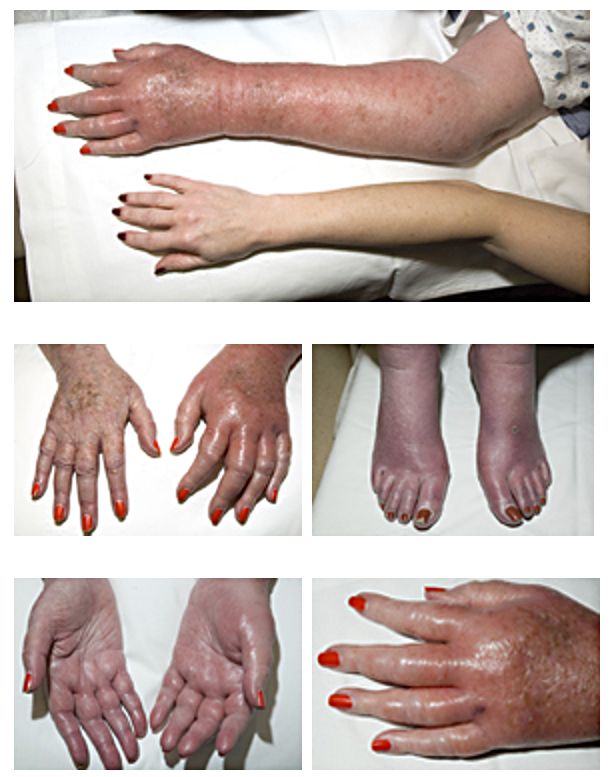
Erythromelalgia: This 77-year-old woman with longstanding polycythemia vera had a six-month history of increasingly prolonged bouts of redness, swelling, and burning pain in her extremities. The severity and sites of involvement varied with each episode. At presentation, she was unable to ambulate without assistance.
by Herbert L. Fred, MD and Hendrik A. van Dijk – http://cnx.org/content/m14932/latest/
Erythromelalgia is a rare disorder that causes episodes of burning pain and redness in the hands and feet, and sometimes the arms, legs, ears and face.
Cooling the skin or raising the affected hands or feet may reduce the pain.
Symptoms can begin at any age. Some people with erythromelalgia may have had it from early childhood, while some are just affected in adult life.
How severe can it be?
People with erythromelalgia typically suffer episodes or flare-ups of severe pain lasting from a few minutes to days.
Flare-ups usually start as an itching sensation, which worsens to a severe burning pain and tender, mottled red skin.
The hands and feet are most commonly affected, usually on both sides of the body, but erythromelalgia can also affect the arms, legs, ears and face.
The pain can be severe enough to make walking, standing, socialising, exercising and sleeping difficult. It can have a significant impact on work or school life.
What are the triggers?
Symptoms are usually triggered by an increase in body temperature.
They can start after exercising, wearing warm socks, gloves or tight shoes, entering a warm room, being dehydrated, or even consuming alcohol or spicy food.
What is the cause?
For most people with erythromelalgia, the cause is unknown.
However, in some cases, an underlying cause may be found – usually a medical condition or a faulty gene (see below).
Underlying disease
Erythromelalgia sometimes results from an underlying disease, such as:
having abnormally high levels of blood cells – either having too many platelets in the blood (thrombocythemia) or too many red blood cells (polycythaemia)
damage to the peripheral nervous system – the network of nerves outside the brain and spinal cord (this damage is known as peripheral neuropathy)
multiple sclerosis (MS) – a disease of the nerves in the brain and spinal cord
an autoimmune problem – such as lupus or rheumatoid arthritis, where the immune system attacks the body’s own tissues
It may also result from certain medications, such as verapamil or nifedipine.
Genetic cause
In some people with erythromelalgia, the disease is caused by a change (mutation) in a gene. This may have occurred spontaneously or been inherited from a parent, meaning that erythromelalgia can run in the family.
Genes contain the genetic information, or the “instructions”, to make a particular protein in the body. Genetic mutations occur when DNA changes, altering the genetic instructions.
Erythromelalgia can be caused by changes in the SCN9A gene that provides the instructions for a sodium channel in pain nerves.
Changes in sodium channels can lead to them opening more easily and staying open longer than usual. This increases or amplifies pain signals.
It is not currently understood why the hands and feet are affected the most.
Can it be treated?
Cooling the skin and elevation
Cooling the skin with a fan or cold water, or raising the affected hands or feet may relieve the pain.
However, using ice or soaking the hands or feet for long amounts of time isn’t recommended, as this can lead to hypothermia or damage to the skin, causing ulcers.
There’s also a risk that the change in temperature will trigger a reactive flare-up when the hands or feet are removed.
Even though a cool environment is helpful in reducing pain during attacks, the use of cold baths or showers is generally discouraged because of potential skin damage.
Your doctor will discuss treatment options with you, as this will also depend on the type or erythromelalgia you have. Many treatments require referral to a specialist centre so that benefits and potential side effects can be closely monitored.
Products used for other types of nerve pain may reduce symptoms.
Products used for high blood pressure or Raynaud’s disease can encourage the blood vessels to widen, and may be beneficial in some types of erythromelalgia.
In adults, aspirin may relieve symptoms if the cause is an abnormally high number of blood cells (aspirin is not recommended for children).